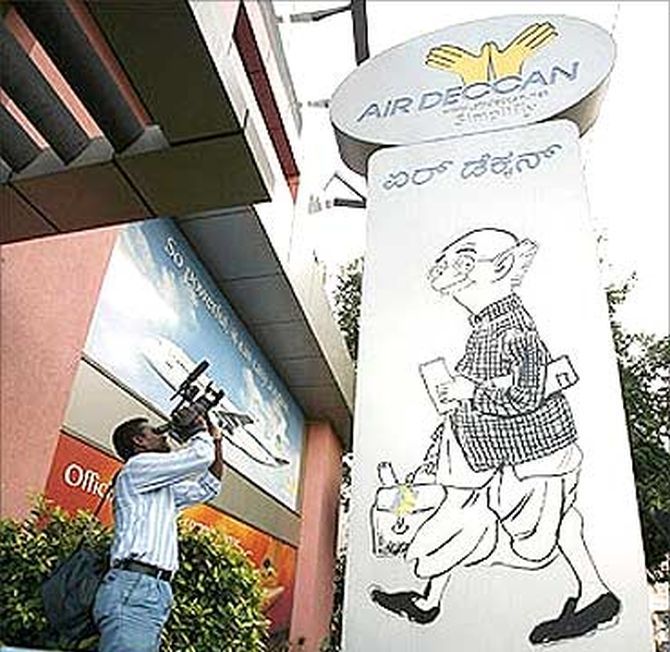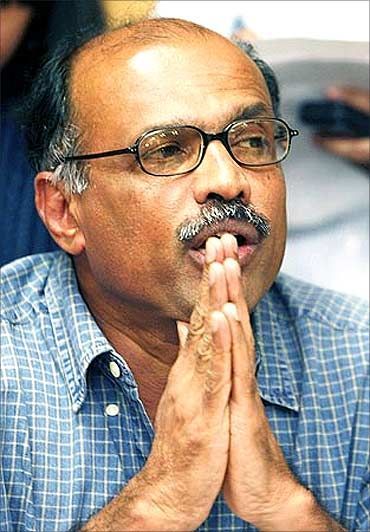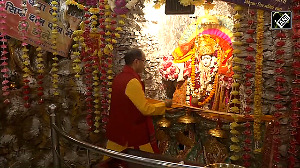'We have replaced an inefficient public sector with a monopolistic private sector.'

Air Deccan, India’s first low-cost airline that made flying affordable for the middle class, is relaunching its operations from December 23.
The airline’s promoter, G R Gopinath, bottom, left, tells Arindam Majumder about the hurdles it faced, the country’s aviation scene and much more. Excerpts:
You were supposed to start operations by September. What took you so long?
We faced huge problems in getting slots at Mumbai and Delhi airports.
I wouldn’t mince words - you can call it monopoly of airport operators, and monopoly is a monster.
Every major city in the world has second airports, and they compete among themselves to attract airlines.
Here, there is no competition. For instance, the Mumbai airport operates around 1,000 flights a day. Most of the flights operated from Mumbai are out of Maharashtra.
But, the Mumbai airport should also serve the people of Maharashtra.
A person from Kolhapur would like to go to Mumbai; a person from Agra would have a need to go to Delhi.
 Smaller cities of the region need to get connected to the hubs, only then connectivity will improve.
Smaller cities of the region need to get connected to the hubs, only then connectivity will improve.
But, I am sorry to say private airports’ policies are not aligned with the UDAN scheme.
What is your suggestion to solve this problem?
Why can’t private airports allocate 25 per cent of their flights for regional aviation?
They are not doing it because it is not attractive in monetary terms, as parking charges of smaller aircraft are less (UDAN flights have zero parking charges).
The government allocates certain portion of its funds for developing rural roads, rural infrastructure, and rural health.
Why can’t a private airport do the same? The DGCA data says annually, Indian airlines sell around 100 million tickets.
But, most of the flying happens between the metros, and they are frequent flyers. UDAN aims to connect the regional cities and bring new flyers in. I have not got parking in Mumbai.
So the aircraft has to fly from Nashik or Kolhapur to Mumbai in the morning.
How does a regional operator make money this way?
But, private airports are not allowing UDAN vision. We have replaced an inefficient public sector with a monopolistic private sector.
How many aircraft will you use to connect the routes?
We have ordered five 20-seater aircraft. One will be based out of Mumbai, one out of Delhi, two will be based out of Kolkata.
Currently, we have three aircraft. All five will be pressed into operation before the end of January, and we will start all the routes that we won in the bid by January.
The smaller the aircraft, harder it is to make money. How do you plan a sustainable operation with 20-seater aircraft?
That’s why we opted for smaller aircraft.
In a 20-seater aircraft, nine seats will be subsidised by the government. I need to find only 11 passengers. Gradually, as demand simulates and the route develops, we will consider putting bigger planes.
I have operated ATRs on thin routes. Much before UDAN started, Air Deccan was flying to places like Kolhapur and northeastern cities. We were the original and first low-cost carrier in India.
Your Rs 1 promotional fare has sparked huge interest.
It’s a promotional offer, to trigger interest in public. To simulate the common man’s aspiration to fly.
A very limited number of seats will be given under the scheme on a first-come-first-served basis, as most of the seats anyway will be priced within Rs 1,500.
You have once again used R K Laxman’s common man for branding. What’s the idea behind it?
While inaugurating the first UDAN flight, PM Modi made an interesting remark.
He said Air India’s logo should be a common man, instead of a Maharaja.
The man you see as Air Deccan’s logo is a common man. He could be anybody’s uncle and can be from anywhere - Delhi, Kolkata or Chennai.
He is a ubiquitous common man of India. Rather than a celebrity, he represents the aspirations of a common Indian, and that is what Air Deccan stands for.












 © 2025
© 2025